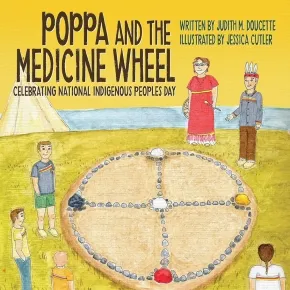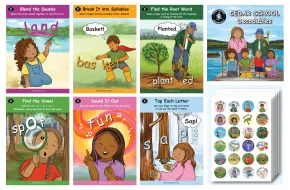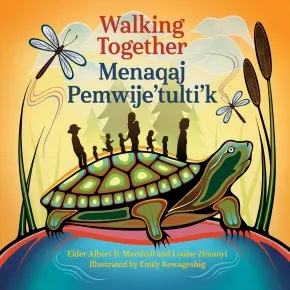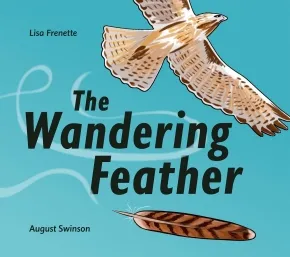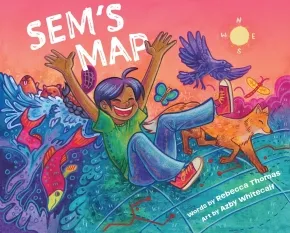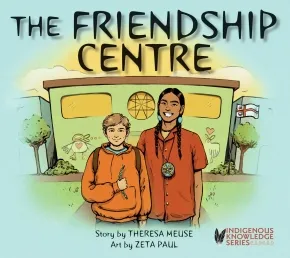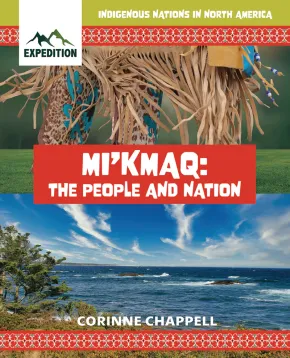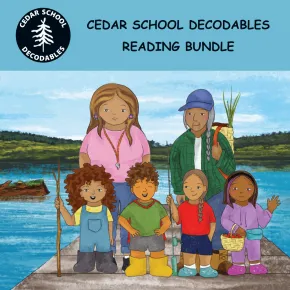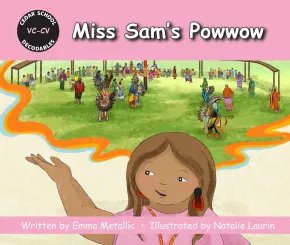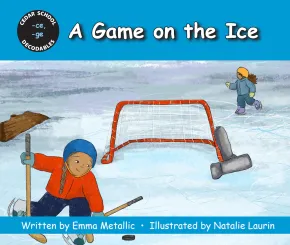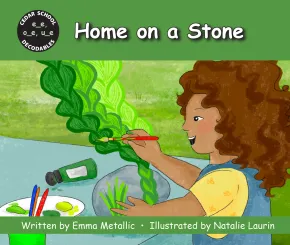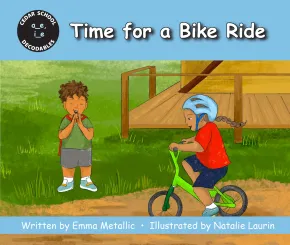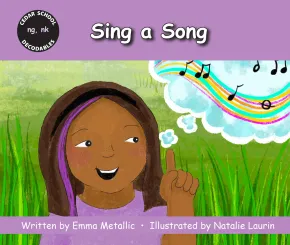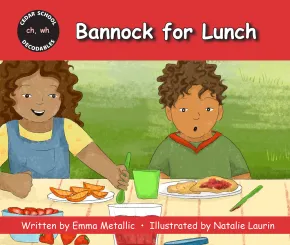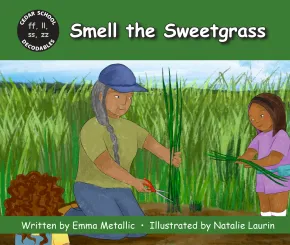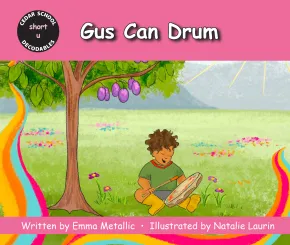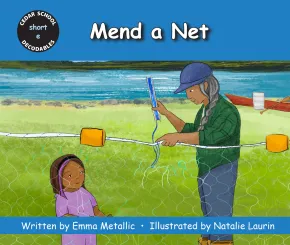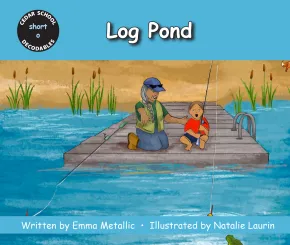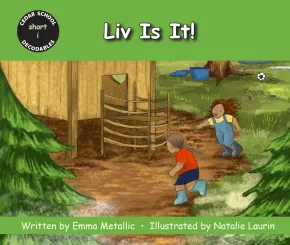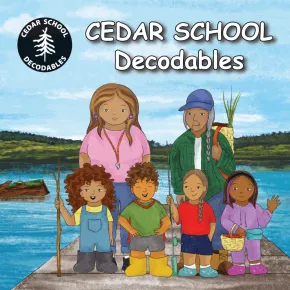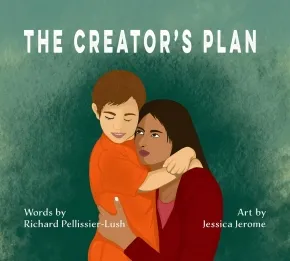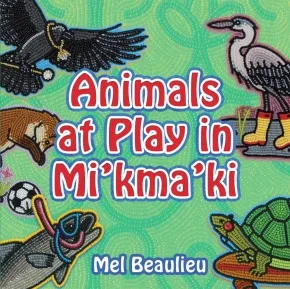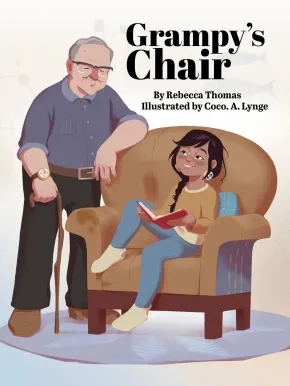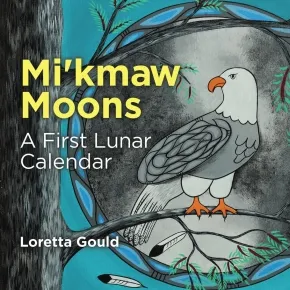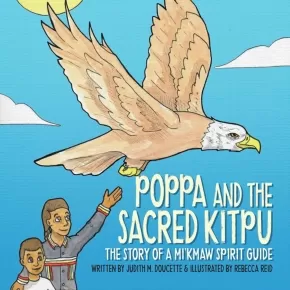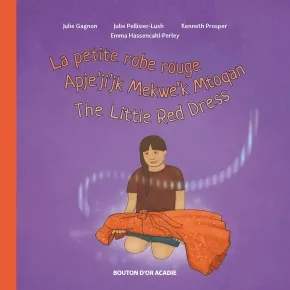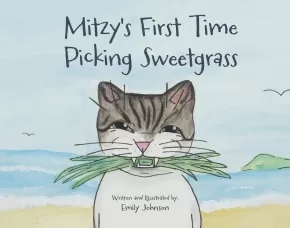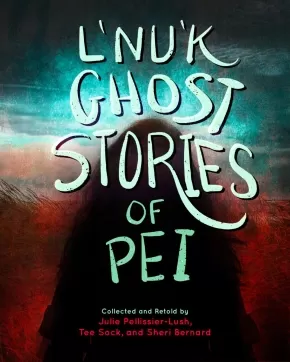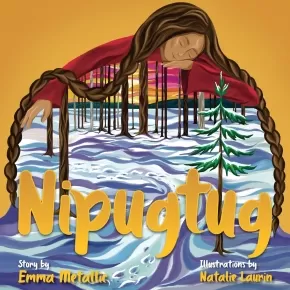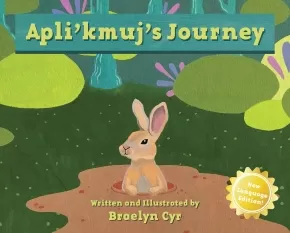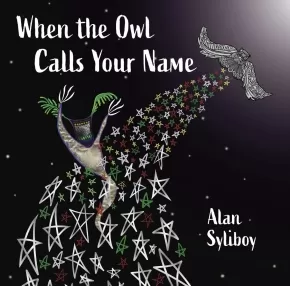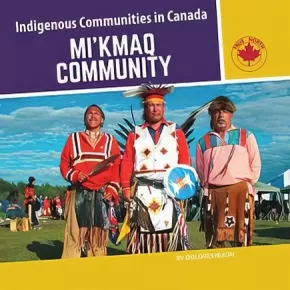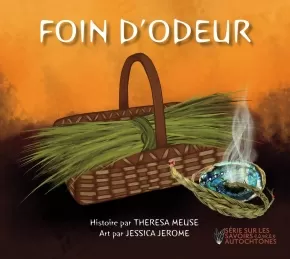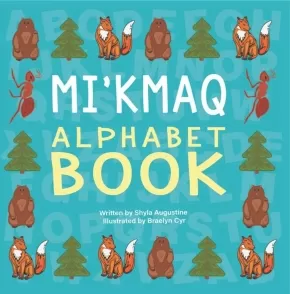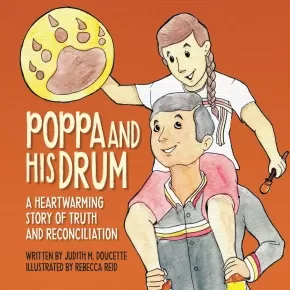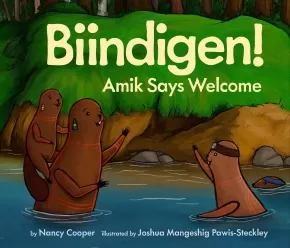
Mi'kmaq (Mi'gmaq)
1
-
15
of
79 Results;
Sort By
Go To
of 6
Poppa and the Medicine Wheel
$18.95
Format:
Paperback
ISBN / Barcode: 9781774572535
Synopsis:
Synopsis:
June 21 is celebrated all over Turtle Island (North America) as National Indigenous People’s Day. François and his friends are excited to celebrate their first public commemoration of this day with Poppa. They will host a morning sunrise ceremony, including Poppa’s teaching on the Seven Lessons of the Mi’kmaw Medicine Wheel.
In this third book of the “Poppa” series, Poppa celebrates his first National Indigenous People’s Day with his Mi’kmaw Community of St. George’s, Newfoundland and Labrador. He can finally do so without fear of discrimination or oppression. After many years of having to hide his Indigenous ancestry, due to the colonial assimilation of his generation, Poppa’s grandson, François, invites him to his school as a respected Mi’kmaw Elder.
Poppa realizes with much joy that his Indigenous culture is bursting with revitalization and renewed pride in a heritage he feared would be lost and forgotten forever. He does not have to practise his cultural ceremonies in private any longer.
Come, join us as we rediscover the teachings of our Mi’kmaw Medicine Wheel and how our ancestors depended on it as a valuable teaching tool for our Peoples. The lessons of the Medicine Wheel are deeply profound and rich with Indigenous spirituality. The Medicine Wheel begs the utmost respect for the Creator as well as every other living creature in existence.
We are all connected in this great circle of life, and we are encouraged to share in each other’s life journey with the help of our Spirit Guides and ancestors’ guidance. Poppa invites us to participate in celebrating the joy of this day with him. Let’s all seek to find our own balance and reconciliation with love and acceptance that can be found within the realms of our own Mi’kmaw Medicine Wheel.
Educator & Series Information
Recommended for ages 5 to 12.
This book is part of the Poppa series.
Additional Information
32 pages | 8.50" x 8.50" | Paperback
Cedar School Decodables with Stickers Sheets and Posters
 $190.70
$190.70

Text Content Territories:
Indigenous Canadian; First Nations; Mi'kmaq (Mi'gmaq);
Grade Levels: Kindergarten; 1;
ISBN / Barcode: n/a
Synopsis:
Synopsis:
This bundle includes the following Cedar School Decodables resources:
- All 20 titles in the Cedar School Decodables series
- Cedar School Decodables Sticker Sheets: Words of Encouragement (Set of Five)
- Cedar School Decodables Posters: Decodable Reading Strategies (Set of Six)
About the Cedar School Decodables Series
Welcome to Cedar School! Join Liv, Tom, Gus, and Bell as they learn on the land and explore Mi’gmaw teachings with their teacher, Miss Sam, and the school’s Mi’gmaw Elder, Jen. With charming illustrations and simple storylines, this decodable series engages students as they practise their reading skills. Each book includes a pre-reading review of non-decodable words, and many of the books introduce special words related to Indigenous teachings. Talking Together prompts facilitate discussions led by the reading teacher.
Developed in partnership with Dyslexia Canada, Cedar School Decodables is a series of 20 decodable books for young readers. Designed for students who have previously learned short vowel and consonant sounds, additional phonic skills are developed progressively throughout the series. Cedar School Decodables is divided into six sets, which increase in word count and complexity of sentence structure:
Set 1 – Short Vowels (40-60 words)
Set 2 – Digraphs (60-80 words)
Set 3 – VCe (80-90 words)
Set 4 – Longer Words (90-100 words)
Set 5 – Ending Spelling Patterns (100-110 words)
Set 6 – R-Controlled Vowels (110-125 words)
This series is recommended for ages 4 to 7 for use in kindergarten and Grade 1 classrooms.
Each book is 16 pages | 6.5” x 5.5” | Paperback
About the Stickers and Posters
Students will love seeing familiar faces from the Cedar School Decodables series as you use the Words of Encouragement stickers and Decodable Reading Strategies Posters to support your structured literacy approach.
The Decodable Reading Strategies Posters share six strategies that students can use to decode new words.
The Words of Encouragement stickers can be used to reinforce learned reading skills, make daily lessons fun and engaging, and celebrate students’ success and achievements.
Scroll below to learn more about the resources included in this bundle. Resource availability may fluctuate.
Walking Together / Menaqaj Pemwije’tulti’k
$24.99
Format:
Hardcover
Text Content Territories:
Indigenous Canadian; First Nations; Mi'kmaq (Mi'gmaq);
ISBN / Barcode: 9781834020174
Synopsis:
Synopsis:
This bestselling and award-winning introduction to Etuaptmumk—the gift of multiple perspectives also known as Two-Eyed Seeing—is now available in a bilingual edition that celebrates the Mi’kmaw language and our connections to nature.
Elder Albert D. Marshall is a leading environmental voice who has brought forward the concept of Etuaptmumk, honoring and braiding both Indigenous and non-Indigenous knowledges and ways of knowing for the benefit of all. Walking Together is grounded in this, as well as in the concept of Netukulimk, meaning to protect Mother Earth for the ancestors and for present and future generations. The journey in Walking Together nurtures respectful, reciprocal, responsible relationships with the Land and Water, with plant life and animals, and with other-than-human beings.
Translated by Barbara Sylliboy and Arlene Stevens, Eskasoni First Nation, Unama’ki (Cape Breton), Nova Scotia, the dual-language text in Mi’kmaw and English furthers Elder Marshall’s lifelong work preserving cultural beliefs and creating a strong vision for his people and for the future. Elder Marshall and Louise Zimanyi are working together to promote Land-based learning through storytelling, an approach that has global relevance for protecting biodiversity, climate action, and resilience. Emily Kewageshig’s evocative artwork illustrates the beauty of connecting with nature and encourages readers to strengthen their relationships to the world around them.
Educator Information
Recommended for ages 4 to 7.
Introduces the concept of Two-Eyed Seeing (the gift of multiple perspectives) to young readers.
Bilingual Edition: Mi’kmaw and English.
This book is available in English: Walking Together
Additional Information
40 pages | 9.00" x 9.00" | Hardcover
The Wandering Feather
$22.95
Format:
Hardcover
Text Content Territories:
Indigenous Canadian;
ISBN / Barcode: 9781771476287
Synopsis:
Synopsis:
In this charming debut, a feather from a red-tailed hawk finds its home in a little girl's dreamcatcher
When a gust of wind blows a feather off a flying red-tailed hawk, it marks the beginning of that feather's quest to find a new home. The feather ends up in a squirrel's nest, a woman's hat, and atop a sandcastle-but none of these spots feel right.
Soon, the feather is picked up by a little girl who lovingly takes it home to join two other feathers as part of a special craft project. When the project is complete, the reader discovers that the feather has found its home in a dreamcatcher.
Bright illustrations bring young readers along on this lost feather's search for purpose, and the heartwarming conclusion weaves in a tribute to an Indigenous cultural object.
Educator Information
Recommended for ages 4 to 7.
Fountas & Pinnell Text Level Gradient: M
Lexile measure: AD630L
Additional Information
32 pages | 8.75" x 7.75" | Hardcover
Sem's Map
$14.95
Artists:
Format:
Paperback
Text Content Territories:
Indigenous Canadian; First Nations; Mi'kmaq (Mi'gmaq);
ISBN / Barcode: 9781774714966
Synopsis:
Synopsis:
From the author of I'm Finding My Talk comes a candid picture book about the importance of Indigenous place names, and acknowledging traditional lands.
Sem is confused. The map Mr. Trainer has just put on the screen is all wrong. It's the same shape as Turtle Island but it's nothing but boxes and lines, and it's filled with names he doesn't know. There's no reference to the stories of the land his Kiju tells him every night while she braids his hair. But Sem's teacher and classmates claim there's nothing wrong. It's the same map they've always used.
See tries to see the land the way Mr. Trainer showed him, but it just doesn't feel right. Where is the story of how the moose gets his dinner? Or where the fish run in the spring? Or when to tap the trees for syrup?
With the help of Kiju, Sem will show his teacher and his classmates how the stories of the land, the Indigenous place names, are far older than any map.
A gentle calling-in, this assured story from Governor General's Award finalist Rebecca Thomas is paired with colourful, lively illustrations from Azby Whitecalf, as well as colonial and decolonial maps of Turtle Island (North America) for reference. Sem's Map is an invaluable resource for caregivers, educators, and young readers about the importance of acknowledging the traditional lands we live on, and unlearning colonial ways of the past.
Educator Information
Recommended for ages 5 to 9.
Themes / Subjects: First Nations, Indigenous Knowledge, place names, land acknowledgement, decolonization, history, social studies
Additional Information
32 pages | 10.00" x 8.00" | Paperback
The Friendship Centre
$13.95
Artists:
Format:
Paperback
Text Content Territories:
Indigenous Canadian; First Nations; Mi'kmaq (Mi'gmaq);
ISBN / Barcode: 9781774714416
Synopsis:
Synopsis:
A modern story of traditional Indigenous knowledge from the author of The Sharing Circle that teaches young readers about the importance of the Friendship Centre for urban Indigenous peoples.
Matthew is visiting his uncle in the big city! He can't wait to tour the Friendship Centre, where Uncle Hunter works, and enjoy all the food, activities, and resources it has to offer.
With language classes, drumming circles, feasts, and more, Matthew learns that the Friendship Centre provides a home away from home for urban Indigenous people. It's a space created for Indigenous people by Indigenous people, and Matthew feels welcomed right away. Matthew drums, smudges, and tastes freshly baked bannock, but his favourite parts of his visit are the people he meets.
From the author of Sweetgrass, The Gathering, and The Sharing Circle, and the illustrator of Muinji'j Asks Why, this story welcomes all into a safe and inviting community space.
Educator & Series Information
Recommended for ages 3 to 7.
This book is part of the Indigenous Knowledge Series.
Additional Information
32 pages | Paperback
Mi'kmaq: The People and Nation
$16.95
Format:
Paperback
Text Content Territories:
Indigenous Canadian; First Nations; Mi'kmaq (Mi'gmaq);
ISBN / Barcode: 9781774567708
Synopsis:
Synopsis:
The Mi'kmaq have many practices in their culture which make them unique. Discover more about the people and nation through Mi'kmaq author Corinne Chappell.
Educator & Series Information
This book is part of the Indigenous Nations in North America series.
Additional Information
32 Pages | Paperback
Baby Smiles/Weskewikwa'sit mijua'ji'j (BB)
$14.95
Artists:
Format:
Board Book
Text Content Territories:
Indigenous Canadian; First Nations; Mi'kmaq (Mi'gmaq);
Grade Levels: Preschool;
ISBN / Barcode: 9781774712214
Synopsis:
Synopsis:
A bilingual Mi'kmaw-English board book promoting dental health in baby's first year.
Every morning and every night I need help brushing my teeth.
Look at me smiling so healthy and happy.
Healthy gums and teeth improve overall wellness and quality of life, and help you feel confident in your smile. Beginning during pregnancy, there are things you can do to support your child's gum and teeth health.
This informative board book written in Mi'kmaw and English will teach caregivers how to support their child's oral health through their first year of life and beyond. Develop healthy habits and learn what food and drink is best for growing teeth and gums, when to take baby to their first dental visit, and the appropriate amount of toothpaste for children.
Written by the Tui'kn Partnership with support from the Dalhousie University Faculty of Dentistry, Baby Smiles will make sure that baby's teeth are healthy and happy their whole life long.
Educator Information
Recommended for ages 3 and under.
Dual-Language: Mi'kmaw-English.
Additional Information
28 pages | 7.00" x 7.00" | Board Book
Cedar School Decodables - Reading Bundle
 $958.80
$958.80

Grade Levels: Kindergarten; 1;
ISBN / Barcode: 9781771746571
Synopsis:
Synopsis:
Welcome to Cedar School! Join Liv, Tom, Gus, and Bell as they learn on the land and explore Mi’gmaw teachings with their teacher, Miss Sam, and the school’s Mi’gmaw Elder, Jen. With charming illustrations and simple storylines, this decodable series engages students as they practise their reading skills. Each book includes a pre-reading review of non-decodable words, and many of the books introduce special words related to Indigenous teachings. Talking Together prompts facilitate discussions led by the reading teacher.
Developed in partnership with Dyslexia Canada, Cedar School Decodables is a series of 20 decodable books for young readers. Designed for students who have previously learned short vowel and consonant sounds, additional phonic skills are developed progressively throughout the series. Cedar School Decodables is divided into six sets, which increase in word count and complexity of sentence structure:
Set 1 – Short Vowels (40-60 words)
Set 2 – Digraphs (60-80 words)
Set 3 – VCe (80-90 words)
Set 4 – Longer Words (90-100 words)
Set 5 – Ending Spelling Patterns (100-110 words)
Set 6 – R-Controlled Vowels (110-125 words)
Educator Information
This bundle includes 120 books: six copies each of the 20 Cedar School Decodables titles. The Cedar School Decodables Teacher’s Guide, which will be available for purchase at a later date, is not included in this bundle.
This series is recommended for ages 4 to 7 for use in kindergarten and Grade 1 classrooms.
Additional Information
Each book is 16 pages | 6.5” x 5.5” | Paperback | Reading Bundle ISBN: 9781771746571
Cedar School Decodables: Elder Jen’s Story
 $7.99
$7.99

Artists:
Format:
Paperback
Text Content Territories:
Indigenous Canadian; First Nations; Mi'kmaq (Mi'gmaq); Listuguj Mi'gmaq First Nation;
Grade Levels: Kindergarten; 1;
ISBN / Barcode: 9781771746540
Synopsis:
Synopsis:
In this story, it is the National Day for Truth and Reconciliation. Jen shares her story of healing with the students.
For a long time, Mi’gmaq were not allowed to speak their language at school. Today, many Mi’gmaq are reconnecting with their language.
How do you honour the National Day for Truth and Reconciliation?
Educator Information
Recommended for ages 4-7, for use in kindergarten and Grade 1 classrooms.
Cedar School Decodables is divided into six sets, which increase in word count and complexity of sentence structure. Elder Jen’s Story is in Set 6 – R-Controlled Vowels, and reviews er, ir, and ur. Books in Set 6 have 110-125 words.
Readers should be familiar with the concepts included in Set 1 to Set 6:
- consonants
- beginning and end blends
- short, long, and r-controlled vowels
- digraphs
- suffixes and ending spelling patterns
- a /o/
- s – /s/ and /z/
- VC-CV, V/CV, VC/V, and compound words
- possessives
Series Information
Welcome to Cedar School! Join Liv, Tom, Gus, and Bell as they learn on the land and explore Mi’gmaw teachings with their teacher, Miss Sam, and the school’s Mi’gmaw Elder, Jen. With charming illustrations and simple storylines, this decodable series engages students as they practise their reading skills. Each book includes a pre-reading review of non-decodable words, and many of the books introduce special words related to Indigenous teachings. Talking Together prompts facilitate discussions led by the reading teacher.
Developed in partnership with Dyslexia Canada, Cedar School Decodables is a series of 20 decodable books for young readers. Designed for students who have previously learned short vowel and consonant sounds, additional phonic skills are developed progressively throughout the series.
The series will be accompanied by Cedar School Decodables Teacher’s Guide and a series of four picture books, which will be available at a later date.
Additional Information
16 pages | 6.5” x 5.5” | Paperback | ISBN: 9781771746540
Cedar School Decodables: The Star World
 $7.99
$7.99

Artists:
Format:
Paperback
Text Content Territories:
Indigenous Canadian; First Nations; Mi'kmaq (Mi'gmaq); Listuguj Mi'gmaq First Nation;
Grade Levels: Kindergarten; 1;
ISBN / Barcode: 9781771746533
Synopsis:
Synopsis:
In this story, Jen shares a Mi’gmaw Creation Story. It explains how Mi’gmaq grew from the earth.
Mi’gmaq pass down knowledge and teachings through storytelling. Some stories are written with pictures instead of words. These pictures are called hieroglyphs.
Can you find the hieroglyph that means “lightning” in the book?
Educator Information
Recommended for ages 4-7, for use in kindergarten and Grade 1 classrooms.
Cedar School Decodables is divided into six sets, which increase in word count and complexity of sentence structure. The Star World is in Set 6 – R-Controlled Vowels, and reviews ar, or, and ore. Books in Set 6 have 110-125 words.
Readers should be familiar with the concepts included in Set 1 to Set 6:
- consonants
- beginning and end blends
- short, long, and r-controlled vowels
- digraphs
- suffixes and ending spelling patterns
- a /o/
- s – /s/ and /z/
- VC-CV, V/CV, VC/V, and compound words
- possessives
Series Information
Welcome to Cedar School! Join Liv, Tom, Gus, and Bell as they learn on the land and explore Mi’gmaw teachings with their teacher, Miss Sam, and the school’s Mi’gmaw Elder, Jen. With charming illustrations and simple storylines, this decodable series engages students as they practise their reading skills. Each book includes a pre-reading review of non-decodable words, and many of the books introduce special words related to Indigenous teachings. Talking Together prompts facilitate discussions led by the reading teacher.
Developed in partnership with Dyslexia Canada, Cedar School Decodables is a series of 20 decodable books for young readers. Designed for students who have previously learned short vowel and consonant sounds, additional phonic skills are developed progressively throughout the series.
The series will be accompanied by Cedar School Decodables Teacher’s Guide and a series of four picture books, which will be available at a later date.
Additional Information
16 pages | 6.5” x 5.5” | Paperback | ISBN: 9781771746533
Cedar School Decodables: Apple Picking
 $7.99
$7.99

Artists:
Format:
Paperback
Text Content Territories:
Indigenous Canadian; First Nations; Mi'kmaq (Mi'gmaq); Listuguj Mi'gmaq First Nation;
Grade Levels: Kindergarten; 1;
ISBN / Barcode: 9781771746526
Synopsis:
Synopsis:
In this story, the class goes apple picking. The air is crisp and chilly. Later, Miss Sam bakes an apple pie to celebrate the fall season.
It is a Mi’gmaw tradition to harvest food with friends and family in the fall.
How do you celebrate fall?
Educator Information
Recommended for ages 4-7, for use in kindergarten and Grade 1 classrooms.
Cedar School Decodables is divided into six sets, which increase in word count and complexity of sentence structure. Apple Picking is in Set 5 – Ending Spelling Patterns, and reviews y (/ī/ and /ē/) and -le. Books in Set 5 have 100-110 words.
Readers should be familiar with the concepts included in Set 1 to Set 5:
- consonants
- beginning and end blends
- short and long vowels
- digraphs
- suffixes and ending spelling patterns
- a /o/
- s – /s/ and /z/
- VC-CV, V/CV, VC/V, and compound words
Series Information
Welcome to Cedar School! Join Liv, Tom, Gus, and Bell as they learn on the land and explore Mi’gmaw teachings with their teacher, Miss Sam, and the school’s Mi’gmaw Elder, Jen. With charming illustrations and simple storylines, this decodable series engages students as they practise their reading skills. Each book includes a pre-reading review of non-decodable words, and many of the books introduce special words related to Indigenous teachings. Talking Together prompts facilitate discussions led by the reading teacher.
Developed in partnership with Dyslexia Canada, Cedar School Decodables is a series of 20 decodable books for young readers. Designed for students who have previously learned short vowel and consonant sounds, additional phonic skills are developed progressively throughout the series.
The series will be accompanied by Cedar School Decodables Teacher’s Guide and a series of four picture books, which will be available at a later date.
Additional Information
16 pages | 6.5” x 5.5” | Paperback | ISBN: 9781771746526
Cedar School Decodables: We Smudge
 $7.99
$7.99

Artists:
Format:
Paperback
Text Content Territories:
Indigenous Canadian; First Nations; Mi'kmaq (Mi'gmaq); Listuguj Mi'gmaq First Nation;
Grade Levels: Kindergarten; 1;
ISBN / Barcode: 9781771746502
Synopsis:
Synopsis:
In this story, Gus and Tom are upset. Miss Sam helps them smudge to feel better.
Mi’gmaq burn sage and other traditional medicines to smudge. Smudging helps people let go of sadness and anger.
What do you do when you are feeling sad?
Educator Information
Recommended for ages 4-7, for use in kindergarten and Grade 1 classrooms.
Cedar School Decodables is divided into six sets, which increase in word count and complexity of sentence structure. We Smudge is in Set 5 – Ending Spelling Patterns, and reviews -tch and -dge. Books in Set 5 have 100-110 words.
Readers should be familiar with the concepts included in Set 1 to Set 5:
- consonants
- beginning and end blends
- short and long vowels
- digraphs
- suffixes and ending spelling patterns
- a /o/
- s – /s/ and /z/
- VC-CV, V/CV, VC/V, and compound words
This book is included in the Indigenous Books for Schools database from the Association of Book Publishers of BC. It is recommended for K to 1 classrooms for English Language Arts and Social Studies.
Series Information
Welcome to Cedar School! Join Liv, Tom, Gus, and Bell as they learn on the land and explore Mi’gmaw teachings with their teacher, Miss Sam, and the school’s Mi’gmaw Elder, Jen. With charming illustrations and simple storylines, this decodable series engages students as they practise their reading skills. Each book includes a pre-reading review of non-decodable words, and many of the books introduce special words related to Indigenous teachings. Talking Together prompts facilitate discussions led by the reading teacher.
Developed in partnership with Dyslexia Canada, Cedar School Decodables is a series of 20 decodable books for young readers. Designed for students who have previously learned short vowel and consonant sounds, additional phonic skills are developed progressively throughout the series.
The series will be accompanied by Cedar School Decodables Teacher’s Guide and a series of four picture books, which will be available at a later date.
Additional Information
16 pages | 6.5” x 5.5” | Paperback | ISBN: 9781771746502
Cedar School Decodables: Wild Strawberries
 $7.99
$7.99

Artists:
Format:
Paperback
Text Content Territories:
Indigenous Canadian; First Nations; Mi'kmaq (Mi'gmaq); Listuguj Mi'gmaq First Nation;
Grade Levels: Kindergarten; 1;
ISBN / Barcode: 9781771746519
Synopsis:
Synopsis:
In this story, Jen and the class pick wild strawberries. Back at school, Jen makes strawberry jam.
Wild strawberries grow throughout Mi’gmaw territory. Mi’gmaq harvest berries and other plants for food and medicine.
Have you ever gone berry picking?
Educator Information
Recommended for ages 4-7, for use in kindergarten and Grade 1 classrooms.
Cedar School Decodables is divided into six sets, which increase in word count and complexity of sentence structure. Wild Strawberries is in Set 5 – Ending Spelling Patterns, and reviews -ild, -old, -ind, -olt, and -ost. Books in Set 5 have 100-110 words.
Readers should be familiar with the concepts included in Set 1 to Set 5:
- consonants
- beginning and end blends
- short and long vowels
- digraphs
- suffixes and ending spelling patterns
- a /o/
- s – /s/ and /z/
- VC-CV, V/CV, VC/V, and compound words
Series Information
Welcome to Cedar School! Join Liv, Tom, Gus, and Bell as they learn on the land and explore Mi’gmaw teachings with their teacher, Miss Sam, and the school’s Mi’gmaw Elder, Jen. With charming illustrations and simple storylines, this decodable series engages students as they practise their reading skills. Each book includes a pre-reading review of non-decodable words, and many of the books introduce special words related to Indigenous teachings. Talking Together prompts facilitate discussions led by the reading teacher.
Developed in partnership with Dyslexia Canada, Cedar School Decodables is a series of 20 decodable books for young readers. Designed for students who have previously learned short vowel and consonant sounds, additional phonic skills are developed progressively throughout the series.
The series will be accompanied by Cedar School Decodables Teacher’s Guide and a series of four picture books, which will be available at a later date.
Additional Information
16 pages | 6.5” x 5.5” | Paperback | ISBN: 9781771746519
Cedar School Decodables: A Forest of Numbers
 $7.99
$7.99

Artists:
Format:
Paperback
Text Content Territories:
Indigenous Canadian; First Nations; Mi'kmaq (Mi'gmaq); Listuguj Mi'gmaq First Nation;
Grade Levels: Kindergarten; 1;
ISBN / Barcode: 9781771746496
Synopsis:
Synopsis:
In this story, the class practises their math skills in the forest by counting what they see. How many birds are in the trees?
Mi’gmaq use math when building, crafting, and making art. Math skills can be used every day!
Can you count along with Bell, Gus, Liv, and Tom?
Educator Information
Recommended for ages 4-7, for use in kindergarten and Grade 1 classrooms.
Cedar School Decodables is divided into six sets, which increase in word count and complexity of sentence structure. A Forest of Numbers is in Set 4 – Longer Words, and reviews open/closed syllable words. Books in Set 4 have 90-100 words.
Readers should be familiar with the concepts included in Set 1 to Set 4:
- consonants
- beginning and end blends
- short and long vowels
- digraphs
- a /o/
- s – /s/ and /z/
- -s, -es, -ed, and -ing suffixes
- VC-CV, V/CV, VC/V, and compound words
- possessives
Series Information
Welcome to Cedar School! Join Liv, Tom, Gus, and Bell as they learn on the land and explore Mi’gmaw teachings with their teacher, Miss Sam, and the school’s Mi’gmaw Elder, Jen. With charming illustrations and simple storylines, this decodable series engages students as they practise their reading skills. Each book includes a pre-reading review of non-decodable words, and many of the books introduce special words related to Indigenous teachings. Talking Together prompts facilitate discussions led by the reading teacher.
Developed in partnership with Dyslexia Canada, Cedar School Decodables is a series of 20 decodable books for young readers. Designed for students who have previously learned short vowel and consonant sounds, additional phonic skills are developed progressively throughout the series.
The series will be accompanied by Cedar School Decodables Teacher’s Guide and a series of four picture books, which will be available at a later date.
Additional Information
16 pages | 6.5” x 5.5” | Paperback | ISBN: 9781771746496
Cedar School Decodables: Miss Sam’s Powwow
 $7.99
$7.99

Artists:
Format:
Paperback
Text Content Territories:
Indigenous Canadian; First Nations; Mi'kmaq (Mi'gmaq); Listuguj Mi'gmaq First Nation;
Grade Levels: Kindergarten; 1;
ISBN / Barcode: 9781771746489
Synopsis:
Synopsis:
In this story, Miss Sam talks to the class about powwows. Miss Sam has danced at powwows since she was a child.
Mi’gmaq gather with their community to dance and sing at powwows. This is also a time for healing and prayers.
What celebrations do you go to?
Educator Information
Recommended for ages 4-7, for use in kindergarten and Grade 1 classrooms.
Cedar School Decodables is divided into six sets, which increase in word count and complexity of sentence structure. Miss Sam’s Powwow is in Set 4 – Longer Words, and reviews closed/closed syllable words and compound words. Books in Set 4 have 90-100 words.
Readers should be familiar with the concepts included in Set 1 to Set 4:
- consonants
- beginning and end blends
- short and long vowels
- digraphs
- a /o/
- s – /s/ and /z/
- -s, -es, -ed, and -ing suffixes
- VC-CV, V/CV, VC/V, and compound words
- possessives
Series Information
Welcome to Cedar School! Join Liv, Tom, Gus, and Bell as they learn on the land and explore Mi’gmaw teachings with their teacher, Miss Sam, and the school’s Mi’gmaw Elder, Jen. With charming illustrations and simple storylines, this decodable series engages students as they practise their reading skills. Each book includes a pre-reading review of non-decodable words, and many of the books introduce special words related to Indigenous teachings. Talking Together prompts facilitate discussions led by the reading teacher.
Developed in partnership with Dyslexia Canada, Cedar School Decodables is a series of 20 decodable books for young readers. Designed for students who have previously learned short vowel and consonant sounds, additional phonic skills are developed progressively throughout the series.
The series will be accompanied by Cedar School Decodables Teacher’s Guide and a series of four picture books, which will be available at a later date.
Additional Information
16 pages | 6.5” x 5.5” | Paperback | ISBN: 9781771746489
Cedar School Decodables: Fishing for Smelts
$7.99
Grade Levels: Kindergarten; 1;
ISBN / Barcode: 9781771746472
Synopsis:
Synopsis:
In this story, Log Pond has frozen over, and the class is ice fishing! Bell sings a song for good luck. Will the class catch anything?
Mi’gmaq go ice fishing in the winter. Traditionally, they used sticks as fishing rods.
Have you ever gone ice fishing?
Educator Information
Recommended for ages 4-7, for use in kindergarten and Grade 1 classrooms.
Cedar School Decodables is divided into six sets, which increase in word count and complexity of sentence structure. Fishing for Smelts is in Set 4 – Longer Words, and reviews -es, -ed (/d/, /t/, and /ǝd/), and -ing. Books in Set 4 have 90-100 words.
Readers should be familiar with the concepts included in Set 1 to Set 4:
- consonants
- beginning and end blends
- short and long vowels
- digraphs
- a /o/
- s – /s/ and /z/
- -s, -es, -ed, and -ing suffixes
- VC-CV, V/CV, VC/V, and compound words
- possessives
Series Information
Welcome to Cedar School! Join Liv, Tom, Gus, and Bell as they learn on the land and explore Mi’gmaw teachings with their teacher, Miss Sam, and the school’s Mi’gmaw Elder, Jen. With charming illustrations and simple storylines, this decodable series engages students as they practise their reading skills. Each book includes a pre-reading review of non-decodable words, and many of the books introduce special words related to Indigenous teachings. Talking Together prompts facilitate discussions led by the reading teacher.
Developed in partnership with Dyslexia Canada, Cedar School Decodables is a series of 20 decodable books for young readers. Designed for students who have previously learned short vowel and consonant sounds, additional phonic skills are developed progressively throughout the series.
The series will be accompanied by Cedar School Decodables Teacher’s Guide and a series of four picture books, which will be available at a later date.
Additional Information
16 pages | 6.5” x 5.5” | Paperback | ISBN: 9781771746472
Cedar School Decodables: A Game on the Ice
 $7.99
$7.99

Artists:
Format:
Paperback
Text Content Territories:
Indigenous Canadian; First Nations; Mi'kmaq (Mi'gmaq); Listuguj Mi'gmaq First Nation;
Grade Levels: Kindergarten; 1;
ISBN / Barcode: 9781771746465
Synopsis:
Synopsis:
In this story, Tom and Liv skate on Log Pond. They play a game of hockey!
Mi’gmaq have played hockey for a long time. Early hockey sticks were carved by Mi’gmaq from birch, elm, or ash wood.
What games do you play in the winter?
Educator Information
Recommended for ages 4-7, for use in kindergarten and Grade 1 classrooms.
Cedar School Decodables is divided into six sets, which increase in word count and complexity of sentence structure. A Game on the Ice is in Set 3 – VCe, and reviews -ce and -ge. Books in Set 3 have 80-90 words.
Readers should be familiar with the concepts included in Set 1 to Set 3:
- consonants
- beginning and end blends
- short and long vowels
- digraphs
- a /o/
- s – /s/ and /z/
- -s and -es suffixes
- possessives
Series Information
Welcome to Cedar School! Join Liv, Tom, Gus, and Bell as they learn on the land and explore Mi’gmaw teachings with their teacher, Miss Sam, and the school’s Mi’gmaw Elder, Jen. With charming illustrations and simple storylines, this decodable series engages students as they practise their reading skills. Each book includes a pre-reading review of non-decodable words, and many of the books introduce special words related to Indigenous teachings. Talking Together prompts facilitate discussions led by the reading teacher.
Developed in partnership with Dyslexia Canada, Cedar School Decodables is a series of 20 decodable books for young readers. Designed for students who have previously learned short vowel and consonant sounds, additional phonic skills are developed progressively throughout the series.
The series will be accompanied by Cedar School Decodables Teacher’s Guide and a series of four picture books, which will be available at a later date.
Additional Information
16 pages | 6.5” x 5.5” | Paperback | ISBN: 9781771746465
Cedar School Decodables: Home on a Stone
 $7.99
$7.99

Artists:
Format:
Paperback
Text Content Territories:
Indigenous Canadian; First Nations; Mi'kmaq (Mi'gmaq); Listuguj Mi'gmaq First Nation;
Grade Levels: Kindergarten; 1;
ISBN / Barcode: 9781771746458
Synopsis:
Synopsis:
In this story, Liv and Bell paint on stones. They think about times when they were outside on the land. What will they choose to paint?
Mi’gmaw art is often inspired by the land. Traditionally, Mi’gmaq made paints from crushed berries and used birch bark as a canvas. Flowers and sunsets are common themes in Mi’gmaw artwork.
What do you like to paint?
Educator Information
Recommended for ages 4-7, for use in kindergarten and Grade 1 classrooms.
Cedar School Decodables is divided into six sets, which increase in word count and complexity of sentence structure. Home on a Stone is in Set 3 – VCe, and reviews e_e, o_e, and u_e (/ū/ and /yū/). Books in Set 3 have 80-90 words.
Readers should be familiar with the concepts included in Set 1 to Set 3:
- consonants
- beginning and end blends
- short and long vowels
- digraphs
- a /o/
- s – /s/ and /z/
- -s and -es suffixes
- possessives
Series Information
Welcome to Cedar School! Join Liv, Tom, Gus, and Bell as they learn on the land and explore Mi’gmaw teachings with their teacher, Miss Sam, and the school’s Mi’gmaw Elder, Jen. With charming illustrations and simple storylines, this decodable series engages students as they practise their reading skills. Each book includes a pre-reading review of non-decodable words, and many of the books introduce special words related to Indigenous teachings. Talking Together prompts facilitate discussions led by the reading teacher.
Developed in partnership with Dyslexia Canada, Cedar School Decodables is a series of 20 decodable books for young readers. Designed for students who have previously learned short vowel and consonant sounds, additional phonic skills are developed progressively throughout the series.
The series will be accompanied by Cedar School Decodables Teacher’s Guide and a series of four picture books, which will be available at a later date.
Additional Information
16 pages | 6.5” x 5.5” | Paperback | ISBN: 9781771746458
Cedar School Decodables: Time for a Bike Ride
 $7.99
$7.99

Artists:
Format:
Paperback
Text Content Territories:
Indigenous Canadian; First Nations; Mi'kmaq (Mi'gmaq); Listuguj Mi'gmaq First Nation;
Grade Levels: Kindergarten; 1;
ISBN / Barcode: 9781771746441
Synopsis:
Synopsis:
In this story, Tom shares his bicycle with Gus, but Gus is nervous about riding it. Will he be brave?
Community is important to Mi’gmaq, which is why Mi’gmaq care for and look after each other. One of the ways they do this is by being a good friend.
Can you think of a time when a friend helped you?
Educator Information
Recommended for ages 4-7, for use in kindergarten and Grade 1 classrooms.
Cedar School Decodables is divided into six sets, which increase in word count and complexity of sentence structure. Time for a Bike Ride is in Set 3 – VCe, and reviews a_e and i_e. Books in Set 3 have 80-90 words.
Readers should be familiar with the concepts included in Set 1 to Set 3:
- consonants
- beginning and end blends
- short and long vowels
- digraphs
- a /o/
- s – /s/ and /z/
- -s and -es suffixes
- possessives
Series Information
Welcome to Cedar School! Join Liv, Tom, Gus, and Bell as they learn on the land and explore Mi’gmaw teachings with their teacher, Miss Sam, and the school’s Mi’gmaw Elder, Jen. With charming illustrations and simple storylines, this decodable series engages students as they practise their reading skills. Each book includes a pre-reading review of non-decodable words, and many of the books introduce special words related to Indigenous teachings. Talking Together prompts facilitate discussions led by the reading teacher.
Developed in partnership with Dyslexia Canada, Cedar School Decodables is a series of 20 decodable books for young readers. Designed for students who have previously learned short vowel and consonant sounds, additional phonic skills are developed progressively throughout the series.
The series will be accompanied by Cedar School Decodables Teacher’s Guide and a series of four picture books, which will be available at a later date.
Additional Information
16 pages | 6.5” x 5.5” | Paperback | ISBN: 9781771746441
Cedar School Decodables: Sing a Song
 $7.99
$7.99

Artists:
Format:
Paperback
Text Content Territories:
Indigenous Canadian; First Nations; Mi'kmaq (Mi'gmaq); Listuguj Mi'gmaq First Nation;
Grade Levels: Kindergarten; 1;
ISBN / Barcode: 9781771746434
Synopsis:
Synopsis:
In this story, Bell and Jen work in the school garden. Bell sings a song to help the plants grow.
It is a Mi’gmaw custom to honour the sun. The sun provides heat and light, which nourish life on Earth. Mi’gmaq honour the sun with songs and ceremonies.
How can you help plants grow?
Educator Information
Recommended for ages 4-7, for use in kindergarten and Grade 1 classrooms.
Cedar School Decodables is divided into six sets, which increase in word count and complexity of sentence structure. Sing a Song is in Set 2 – Digraphs, and reviews ng and nk. Books in Set 2 have 60-80 words.
Readers should be familiar with the concepts included in Set 1 and Set 2:
- consonants
- beginning and end blends
- short vowels
- digraphs
- a /o/
- s – /s/ and /z/
- -s suffix
Series Information
Welcome to Cedar School! Join Liv, Tom, Gus, and Bell as they learn on the land and explore Mi’gmaw teachings with their teacher, Miss Sam, and the school’s Mi’gmaw Elder, Jen. With charming illustrations and simple storylines, this decodable series engages students as they practise their reading skills. Each book includes a pre-reading review of non-decodable words, and many of the books introduce special words related to Indigenous teachings. Talking Together prompts facilitate discussions led by the reading teacher.
Developed in partnership with Dyslexia Canada, Cedar School Decodables is a series of 20 decodable books for young readers. Designed for students who have previously learned short vowel and consonant sounds, additional phonic skills are developed progressively throughout the series.
The series will be accompanied by Cedar School Decodables Teacher’s Guide and a series of four picture books, which will be available at a later date.
Additional Information
16 pages | 6.5” x 5.5” | Paperback | ISBN: 9781771746434
Cedar School Decodables: Bannock for Lunch
 $7.99
$7.99

Artists:
Format:
Paperback
Text Content Territories:
Indigenous Canadian; First Nations; Mi'kmaq (Mi'gmaq); Listuguj Mi'gmaq First Nation;
Grade Levels: Kindergarten; 1;
ISBN / Barcode: 9781771746427
Synopsis:
Synopsis:
In this story, the class enjoys a picnic lunch. They eat bannock, jam, and other tasty foods.
Bannock is a type of bread that is important to Mi’gmaq. Bannock is often eaten with jam or butter.
What is your favourite lunch food?
Educator Information
Recommended for ages 4-7, for use in kindergarten and Grade 1 classrooms.
Cedar School Decodables is divided into six sets, which increase in word count and complexity of sentence structure. Bannock for Lunch is in Set 2 – Digraphs, and reviews ch and wh. Books in Set 2 have 60-80 words.
Readers should be familiar with the concepts included in Set 1 and Set 2:
- consonants
- beginning and end blends
- short vowels
- digraphs
- a /o/
- s – /s/ and /z/
- -s suffix
Series Information
Welcome to Cedar School! Join Liv, Tom, Gus, and Bell as they learn on the land and explore Mi’gmaw teachings with their teacher, Miss Sam, and the school’s Mi’gmaw Elder, Jen. With charming illustrations and simple storylines, this decodable series engages students as they practise their reading skills. Each book includes a pre-reading review of non-decodable words, and many of the books introduce special words related to Indigenous teachings. Talking Together prompts facilitate discussions led by the reading teacher.
Developed in partnership with Dyslexia Canada, Cedar School Decodables is a series of 20 decodable books for young readers. Designed for students who have previously learned short vowel and consonant sounds, additional phonic skills are developed progressively throughout the series.
The series will be accompanied by Cedar School Decodables Teacher’s Guide and a series of four picture books, which will be available at a later date.
Additional Information
16 pages | 6.5” x 5.5” | Paperback | ISBN: 9781771746427
Cedar School Decodables: What Track Is This?
$7.99
Artists:
Format:
Paperback
Text Content Territories:
Indigenous Canadian; First Nations; Mi'kmaq (Mi'gmaq); Listuguj Mi'gmaq First Nation;
Grade Levels: Kindergarten; 1;
ISBN / Barcode: 9781771746410
Synopsis:
Synopsis:
In this story, Miss Sam and the class are exploring the forest when they see an animal track on Cub Path! What animal made it?
Mi’gmaq use tracks to find animals in the forest. Mi’gmaq live in balance with the land and honour the animals that live on it.
Have you ever seen an animal track?
Educator Information
Recommended for ages 4-7, for use in kindergarten and Grade 1 classrooms.
Cedar School Decodables is divided into six sets, which increase in word count and complexity of sentence structure. What Track Is This? is in Set 2 – Digraphs, and reviews ck, sh, and th (voiced and unvoiced). Books in Set 2 have 60-80 words.
Readers should be familiar with the concepts included in Set 1 and Set 2:
- consonants
- beginning and end blends
- short vowels
- digraphs
- a /o/
- s – /s/ and /z/
- -s suffix
Series Information
Welcome to Cedar School! Join Liv, Tom, Gus, and Bell as they learn on the land and explore Mi’gmaw teachings with their teacher, Miss Sam, and the school’s Mi’gmaw Elder, Jen. With charming illustrations and simple storylines, this decodable series engages students as they practise their reading skills. Each book includes a pre-reading review of non-decodable words, and many of the books introduce special words related to Indigenous teachings. Talking Together prompts facilitate discussions led by the reading teacher.
Developed in partnership with Dyslexia Canada, Cedar School Decodables is a series of 20 decodable books for young readers. Designed for students who have previously learned short vowel and consonant sounds, additional phonic skills are developed progressively throughout the series.
The series will be accompanied by Cedar School Decodables Teacher’s Guide and a series of four picture books, which will be available at a later date.
Additional Information
16 pages | 6.5” x 5.5” | Paperback | ISBN: 9781771746410
Cedar School Decodables: Smell the Sweetgrass
 $7.99
$7.99

Artists:
Format:
Paperback
Text Content Territories:
Indigenous Canadian; First Nations; Mi'kmaq (Mi'gmaq); Listuguj Mi'gmaq First Nation;
Grade Levels: Kindergarten; 1;
ISBN / Barcode: 9781771746403
Synopsis:
Synopsis:
In this story, Jen takes the class on an adventure to harvest sweetgrass.
Sweetgrass is a traditional medicine plant for Mi’gmaq. The grass can be braided and given to friends and family. Mi’gmaq give thanks to the land before a harvest.
How can you give thanks to the land?
Educator Information
Recommended for ages 4-7, for use in kindergarten and Grade 1 classrooms.
Cedar School Decodables is divided into six sets, which increase in word count and complexity of sentence structure. Smell the Sweetgrass is in Set 2 – Digraphs, and reviews the FLSZ spelling rule (ff, ll, ss, zz). Books in Set 2 have 60-80 words.
Readers should be familiar with the concepts included in Set 1 and Set 2:
- consonants
- beginning and end blends
- short vowels
- digraphs
- a /o/
- s – /s/ and /z/
- -s suffix
Series Information
Welcome to Cedar School! Join Liv, Tom, Gus, and Bell as they learn on the land and explore Mi’gmaw teachings with their teacher, Miss Sam, and the school’s Mi’gmaw Elder, Jen. With charming illustrations and simple storylines, this decodable series engages students as they practise their reading skills. Each book includes a pre-reading review of non-decodable words, and many of the books introduce special words related to Indigenous teachings. Talking Together prompts facilitate discussions led by the reading teacher.
Developed in partnership with Dyslexia Canada, Cedar School Decodables is a series of 20 decodable books for young readers. Designed for students who have previously learned short vowel and consonant sounds, additional phonic skills are developed progressively throughout the series.
The series will be accompanied by Cedar School Decodables Teacher’s Guide and a series of four picture books, which will be available at a later date.
Additional Information
16 pages | 6.5” x 5.5” | Paperback | ISBN: 9781771746403
Cedar School Decodables: Gus Can Drum
 $7.99
$7.99

Artists:
Format:
Paperback
Text Content Territories:
Indigenous Canadian; First Nations; Mi'kmaq (Mi'gmaq); Listuguj Mi'gmaq First Nation;
Grade Levels: Kindergarten; 1;
ISBN / Barcode: 9781771746380
Synopsis:
Synopsis:
In this story, Gus learns to drum. He drums to the sun and his favourite animals.
Mi’gmaq use moose hide to make drums. Drumming is medicine to Mi’gmaq. The drum sounds like the beat of Mother Earth’s heart.
Have you ever played a drum?
Educator Information
Recommended for ages 4-7, for use in kindergarten and Grade 1 classrooms.
Cedar School Decodables is divided into six sets, which increase in word count and complexity of sentence structure. Gus Can Drum is in Set 1 – Short Vowels, and reviews short u. Books in Set 1 have 40-60 words.
Readers should be familiar with the concepts included in Set 1:
- consonants
- beginning and end blends
- short vowels
- s – /s/ and /z/
- -s suffix
Series Information
Welcome to Cedar School! Join Liv, Tom, Gus, and Bell as they learn on the land and explore Mi’gmaw teachings with their teacher, Miss Sam, and the school’s Mi’gmaw Elder, Jen. With charming illustrations and simple storylines, this decodable series engages students as they practise their reading skills. Each book includes a pre-reading review of non-decodable words, and many of the books introduce special words related to Indigenous teachings. Talking Together prompts facilitate discussions led by the reading teacher.
Developed in partnership with Dyslexia Canada, Cedar School Decodables is a series of 20 decodable books for young readers. Designed for students who have previously learned short vowel and consonant sounds, additional phonic skills are developed progressively throughout the series.
The series will be accompanied by Cedar School Decodables Teacher’s Guide and a series of four picture books, which will be available at a later date.
Additional Information
16 pages | 6.5” x 5.5” | Paperback | ISBN: 9781771746380
Cedar School Decodables: Mend a Net
$7.99
Artists:
Format:
Paperback
Text Content Territories:
Indigenous Canadian; First Nations; Mi'kmaq (Mi'gmaq); Listuguj Mi'gmaq First Nation;
Grade Levels: Kindergarten; 1;
ISBN / Barcode: 9781771746397
Synopsis:
Synopsis:
In this story, the class learns how to fish for salmon with a net. But first, Jen must mend the net!
Salmon fishing is important to Mi’gmaq. Mi’gmaq use nets to fish for salmon in large rivers. Traditionally, the inner part of pine trees was used to make and mend nets.
Have you ever seen a fishing net?
Educator Information
Recommended for ages 4-7, for use in kindergarten and Grade 1 classrooms.
Cedar School Decodables is divided into six sets, which increase in word count and complexity of sentence structure. Mend a Net is in Set 1 – Short Vowels, and reviews short e. Books in Set 1 have 40-60 words.
Readers should be familiar with the concepts included in Set 1:
- consonants
- beginning and end blends
- short vowels
- s – /s/ and /z/
- -s suffix
Series Information
Welcome to Cedar School! Join Liv, Tom, Gus, and Bell as they learn on the land and explore Mi’gmaw teachings with their teacher, Miss Sam, and the school’s Mi’gmaw Elder, Jen. With charming illustrations and simple storylines, this decodable series engages students as they practise their reading skills. Each book includes a pre-reading review of non-decodable words, and many of the books introduce special words related to Indigenous teachings. Talking Together prompts facilitate discussions led by the reading teacher.
Developed in partnership with Dyslexia Canada, Cedar School Decodables is a series of 20 decodable books for young readers. Designed for students who have previously learned short vowel and consonant sounds, additional phonic skills are developed progressively throughout the series.
The series will be accompanied by Cedar School Decodables Teacher’s Guide and a series of four picture books, which will be available at a later date.
Additional Information
16 pages | 6.5” x 5.5” | Paperback | ISBN: 9781771746397
Cedar School Decodables: Log Pond
 $7.99
$7.99

Artists:
Format:
Paperback
Text Content Territories:
Indigenous Canadian; First Nations; Mi'kmaq (Mi'gmaq); Listuguj Mi'gmaq First Nation;
Grade Levels: Kindergarten; 1;
ISBN / Barcode: 9781771746373
Synopsis:
Synopsis:
In this story, Tom and Jen go fishing at Log Pond. Tom sees a frog and a fox, and then he catches a fish!
Mi’gmaq fish to provide food for their families and communities. The first catch is always given to family or Elders.
Have you ever gone fishing?
Educator Information
Recommended for ages 4-7, for use in kindergarten and Grade 1 classrooms.
Cedar School Decodables is divided into six sets, which increase in word count and complexity of sentence structure. Log Pond is in Set 1 – Short Vowels, and reviews short o. Books in Set 1 have 40-60 words.
Readers should be familiar with the concepts included in Set 1:
- consonants
- beginning and end blends
- short vowels
- s – /s/ and /z/
- -s suffix
Series Information
Welcome to Cedar School! Join Liv, Tom, Gus, and Bell as they learn on the land and explore Mi’gmaw teachings with their teacher, Miss Sam, and the school’s Mi’gmaw Elder, Jen. With charming illustrations and simple storylines, this decodable series engages students as they practise their reading skills. Each book includes a pre-reading review of non-decodable words, and many of the books introduce special words related to Indigenous teachings. Talking Together prompts facilitate discussions led by the reading teacher.
Developed in partnership with Dyslexia Canada, Cedar School Decodables is a series of 20 decodable books for young readers. Designed for students who have previously learned short vowel and consonant sounds, additional phonic skills are developed progressively throughout the series.
The series will be accompanied by Cedar School Decodables Teacher’s Guide and a series of four picture books, which will be available at a later date.
Additional Information
16 pages | 6.5” x 5.5” | Paperback | ISBN: 9781771746373
Cedar School Decodables: Liv Is It!
 $7.99
$7.99

Artists:
Format:
Paperback
Text Content Territories:
Indigenous Canadian; First Nations; Mi'kmaq (Mi'gmaq); Listuguj Mi'gmaq First Nation;
Grade Levels: Kindergarten; 1;
ISBN / Barcode: 9781771746366
Synopsis:
Synopsis:
In this story, Tom and Liv play tag in the forest. They run and hide among cedar, birch, and maple trees.
Cedar is a traditional medicine tree for Mi’gmaq. Birch bark is used by Mi’gmaq to make many things, including canoes and moose callers. Traditionally, Mi’gmaq used birch bark bowls to collect maple sap.
What kind of trees grow where you live?
Educator Information
Recommended for ages 4-7, for use in kindergarten and Grade 1 classrooms.
Cedar School Decodables is divided into six sets, which increase in word count and complexity of sentence structure. Liv Is It! is in Set 1 – Short Vowels, and reviews short i. Books in Set 1 have 40-60 words. Books in Set 1 have 40-60 words.
Readers should be familiar with the concepts included in Set 1:
- consonants
- beginning and end blends
- short vowels
- s – /s/ and /z/
- -s suffix
Series Information
Welcome to Cedar School! Join Liv, Tom, Gus, and Bell as they learn on the land and explore Mi’gmaw teachings with their teacher, Miss Sam, and the school’s Mi’gmaw Elder, Jen. With charming illustrations and simple storylines, this decodable series engages students as they practise their reading skills. Each book includes a pre-reading review of non-decodable words, and many of the books introduce special words related to Indigenous teachings. Talking Together prompts facilitate discussions led by the reading teacher.
Developed in partnership with Dyslexia Canada, Cedar School Decodables is a series of 20 decodable books for young readers. Designed for students who have previously learned short vowel and consonant sounds, additional phonic skills are developed progressively throughout the series.
The series will be accompanied by Cedar School Decodables Teacher’s Guide and a series of four picture books, which will be available at a later date.
Additional Information
16 pages | 6.5” x 5.5” | Paperback | ISBN: 9781771746366
Cedar School Decodables: Sap!
 $7.99
$7.99

Artists:
Format:
Paperback
Text Content Territories:
Indigenous Canadian; First Nations; Mi'kmaq (Mi'gmaq); Listuguj Mi'gmaq First Nation;
Grade Levels: Kindergarten; 1;
ISBN / Barcode: 9781771746359
Synopsis:
Synopsis:
In this story, Tom and Liv learn how to collect sap from maple trees. Back at school, Miss Sam heats the sap, and it turns into maple syrup!
Mi’gmaq use maple syrup to sweeten their foods and as medicine.
Have you ever tasted maple syrup?
Educator Information
Recommended for ages 4-7, for use in kindergarten and Grade 1 classrooms.
Cedar School Decodables is divided into six sets, which increase in word count and complexity of sentence structure. Sap! is in Set 1 – Short Vowels, and reviews short a and nasalized a. Books in Set 1 have 40-60 words.
Readers should be familiar with the concepts included in Set 1:
- consonants
- beginning and end blends
- short vowels
- s – /s/ and /z/
- -s suffix
Series Information
Welcome to Cedar School! Join Liv, Tom, Gus, and Bell as they learn on the land and explore Mi’gmaw teachings with their teacher, Miss Sam, and the school’s Mi’gmaw Elder, Jen. With charming illustrations and simple storylines, this decodable series engages students as they practise their reading skills. Each book includes a pre-reading review of non-decodable words, and many of the books introduce special words related to Indigenous teachings. Talking Together prompts facilitate discussions led by the reading teacher.
Developed in partnership with Dyslexia Canada, Cedar School Decodables is a series of 20 decodable books for young readers. Designed for students who have previously learned short vowel and consonant sounds, additional phonic skills are developed progressively throughout the series.
The series will be accompanied by Cedar School Decodables Teacher’s Guide and a series of four picture books, which will be available at a later date.
Additional Information
16 pages | 6.5” x 5.5” | Paperback | ISBN: 9781771746359
Cedar School Decodables - Series Bundle
 $159.80
$159.80

Text Content Territories:
Indigenous Canadian; First Nations; Mi'kmaq (Mi'gmaq); Listuguj Mi'gmaq First Nation;
Grade Levels: Kindergarten; 1;
ISBN / Barcode: 9781771746557
Synopsis:
Synopsis:
Welcome to Cedar School! Join Liv, Tom, Gus, and Bell as they learn on the land and explore Mi’gmaw teachings with their teacher, Miss Sam, and the school’s Mi’gmaw Elder, Jen. With charming illustrations and simple storylines, this decodable series engages students as they practise their reading skills. Each book includes a pre-reading review of non-decodable words, and many of the books introduce special words related to Indigenous teachings. Talking Together prompts facilitate discussions led by the reading teacher.
Developed in partnership with Dyslexia Canada, Cedar School Decodables is a series of 20 decodable books for young readers. Designed for students who have previously learned short vowel and consonant sounds, additional phonic skills are developed progressively throughout the series. Cedar School Decodables is divided into six sets, which increase in word count and complexity of sentence structure:
Set 1 – Short Vowels (40-60 words)
Set 2 – Digraphs (60-80 words)
Set 3 – VCe (80-90 words)
Set 4 – Longer Words (90-100 words)
Set 5 – Ending Spelling Patterns (100-110 words)
Set 6 – R-Controlled Vowels (110-125 words)
Educator Information
This bundle includes 20 books: one copy each of the 20 Cedar School Decodables titles. The Cedar School Decodables Teacher’s Guide, which will be available for purchase at a later date, is not included in this bundle.
This series is recommended for ages 4 to 7 for use in kindergarten and Grade 1 classrooms.
Additional Information
Each book is 16 pages | 6.5” x 5.5” | Paperback | Series ISBN: 9781771746557
The Creator's Plan
$14.95
Artists:
Format:
Paperback
Text Content Territories:
Indigenous Canadian; First Nations; Mi'kmaq (Mi'gmaq); Lennox Island First Nation;
ISBN / Barcode: 9781773661704
Synopsis:
Synopsis:
"My son, you do not need black hair, brown skin, or brown eyes like me to pray and practice your culture. You will learn the songs and the drumming in time. The Creator's plan was to give you everything that makes you who you are, and you are perfect to me just the way you are! Always remember that, no matter what anyone else says to you. We need to pray for those children too, my son, as hard as that may seem. But remember, you are exactly how the Creator planned you to be, and I will love you until the end of time."
As a Mi'kmaq child, Richard Pellissier-Lush grew looking different than other the other Indigenous children. He didn't feel he fit in with the non-Indigenous or the Indigenous children he knew. But his mother continually reminding him that he was part of the Creator's plan empowered him to embrace his culture no matter what he looked like. Her chorus of encouragement stayed with him through his childhood and helped make him the man he is today.
Educator Information
Recommended for ages 4 to 7.
Additional Information
32 pages | 9.00" x 9.00" | Paperback
Animals at Play in Mi'kma'ki (BB)
$16.95
Format:
Board Book
Text Content Territories:
Indigenous Canadian; First Nations; Mi'kmaq (Mi'gmaq);
Grade Levels: Preschool; Kindergarten;
ISBN / Barcode: 9781459507449
Synopsis:
Synopsis:
In this fun board book for young kids, turtles skateboard, salmon snorkel, bears take photos and otters frolic with floaties!
Mi’kmaw artist Mel Beaulieu’s lively modern take on traditional beadwork brings these animals to life. Mi’kma’ki’s most iconic animals are portrayed in this colourful and whimsical book.
Mi’kmaw names (and pronunciation guides) make this a great introduction to contemporary Mi’kma’ki for very young children.
Educator Information
Recommended for ages 2 to 5.
Additional Information
6.53" x 6.53 | Board Book
Grampy's Chair
$23.99
Artists:
Format:
Hardcover
Text Content Territories:
Indigenous Canadian; First Nations; Mi'kmaq;
ISBN / Barcode: 9781773219189
Synopsis:
Synopsis:
A heartwarming story about lifelong love and loss told from the perspective of a grandfather’s favorite chair.
Grampy’s chair sits in the middle of his living room and always keeps an eye on My Love. The Chair is the perfect spot for My Love to learn to read, to play games with her friends, and The Chair is always extra soft when My Love is sick. As My Love grows up, The Chair sees Grampy grow older and My Love must care for him. One day Grampy is gone, and The Chair is moved to a space with only a few things it recognizes (and a few spiders too). Will it see My Love again?
In this poignant story inspired by her own grandfather and his chair, Rebecca Thomas invites readers of all ages to explore love, grief, and the important moments in life that take place in our favorite spots. With lively illustrations from Coco A. Lynge and featuring a heartfelt author’s note, Grampy's Chair takes the readers through loss, and how we can be found again by the ones we love.
Educator Information
Recommended for ages 4 to 7.
Additional Information
36 pages | 7.65" x 10.25" | Hardcover
Walking Together (PB)
$12.99
Format:
Paperback
Text Content Territories:
Indigenous Canadian; First Nations; Mi'kmaq;
ISBN / Barcode: 9781773217772
Synopsis:
Synopsis:
This bestselling, innovative picture book introduces readers to the concept of Etuaptmumk—or Two-Eyed Seeing, the gift of multiple perspectives in the Mi’kmaw language—as we follow a group of young children connecting to nature as their teacher.
A poetic, joyful celebration of the Lands and Waters as spring unfolds: we watch for Robin's return, listen for Frog's croaking, and wonder at maple tree's gift of sap. Grounded in Etuaptmumk, also known as Two-Eyed Seeing—which braids together the strengths of Indigenous and non-Indigenous ways of knowing—and the Mi’kmaq concept of Netukulimk—meaning to protect Mother Earth for the ancestors, present, and future generations—Walking Together nurtures respectful, reciprocal, responsible relationships with the Land and Water, plant-life, animals and other-than-human beings for the benefit of all.
Reviews
"Walking Together is a poetic celebration grounded in Etuaptmumk (Two-Eyed Seeing) that weaves together the strengths of Indigenous and non-Indigenous ways of knowing. The story explores respectful, reciprocal, responsible relationships between the land, water, plants, animals, and humans." - The Dalai Lama Center
Educator Information
Recommended for ages 4 to 7.
Introduces the concept of Two-Eyed Seeing (the gift of multiple perspectives) to young readers.
This book is available in a bilingual format: Walking Together / Menaqaj Pemwije’tulti’k
Additional Information
36 pages | 8.90" x 8.90" | Paperback
Mi'kmaw Moons: A First Lunar Calendar (BB)
$16.95
Artists:
Format:
Board Book
Text Content Territories:
Indigenous Canadian; First Nations; Mi'kmaq;
Grade Levels: Preschool; Kindergarten;
ISBN / Barcode: 9781459507456
Synopsis:
Synopsis:
This board book presents the months of the Mi’kmaw lunar calendar to very young children and their parents. Mi’kmaw artist Loretta Gould’s art illustrates each of the 12 Mi’kmaw moons through the changing seasons in Mi’kma’ki. Each month is named after events in the natural world – from Snow Blinding Time through Frogs Croaking Time and Berry Ripening Time. Each month’s illustration is accompanied by its name in Mi’kmaw and English.
Loretta Gould’s art, first published in Mi’kmaw Moons: A First Lunar Calendar has won high praise from reviewers, and the book has received numerous awards.
Educator Information
For ages 2 to 5.
Includes names of the months in English and Mi'kmaw.
This is the board book version of Mi'kmaw Moons: The Seasons in Mi'kma'ki.
Additional Information
6.53" x 6.53" | Board Book
Poppa and the Sacred Kitpu
$18.95
Artists:
Format:
Paperback
Text Content Territories:
Indigenous Canadian; First Nations; Mi'kmaq;
ISBN / Barcode: 9781774571859
Synopsis:
Synopsis:
After being invited into his grandson’s school to share his wisdom and knowledge of his traditional Mi’kmaw culture in Poppa and His Drum, Poppa is happy to return as a respected Indigenous Elder and Knowledge Keeper.
In this second book of the Poppa series, we find Poppa giving his next gin’masuti (lesson in our culture) to his grandson, François, and his friends, Paul and Joe.
The boys have an important art project to complete for school and are not sure what to do. While spending the afternoon on a beach adventure with Poppa, the boys get to learn about the Sacred Kitpu (Bald Eagle) and why it’s so important to our Indigenous People.
Poppa engages the children with eager imaginations of how the Sacred Kitpu is not only a powerful spirit guide, but also represents the Spirit of the Creator among us. It is the messenger between Mother Earth and the Spirit World, whispering to the Creator our prayers, touching the face of the Creator with its wing.
Poppa teaches the children through mystic wonder how we use the Sacred Kitpu feather in many different cultural ceremonies. He embraces their eagerness to learn and shares the tradition of smudging, using the Kitpu feather along with Sacred Medicines that burn in a smudge bowl to purify our body, mind, and spirit.
The children delight in discovering Poppa’s never-spoken-of regalia treasures that once belonged to his grandfather and decide to commemorate their art project to the Sacred Kitpu.
Poppa is invited back to the class to award the winning medal to the winners of the arts project. He is proud to present the medals to happy children who truly understand and appreciate the importance of the role the Sacred Kitpu plays in our Mi’kmaw culture and heritage. Poppa and the Sacred Kitpu will delight and surprise the reader with fun and teachings given by the love of a Poppa who is cherished by his community for being such a wonderful Mi’kmaw Elder.
Educator & Series Information
Recommended for ages 5 to 12.
This book is the second book in the Poppa series, following Poppa and His Drum.
Additional Information
9.00" x 9.00" | Paperback
Indiginerds: Tales from Modern Indigenous Life
$30.95
Artists:
Format:
Paperback
Text Content Territories:
Indigenous Canadian;
ISBN / Barcode: 9781638991335
Synopsis:
Synopsis:
First Nations culture is living, vibrant, and evolving, and generations of Indigenous kids have grown up with pop culture creeping inexorably into our lives. From gaming to social media, pirate radio to garage bands, Star Trek to D&D, and missed connections at the pow wow, Indigenous culture is so much more than how it’s usually portrayed. Indiginerds is here to celebrate those stories!
Featuring an all-Indigenous creative team, Indiginerds is an exhilarating anthology collecting 11 stories about Indigenous people balancing traditional ways of knowing with modern pop culture. Includes work by Alina Pete, PJ Underwood, Kameron White, Rhael McGregory, and many more.
Educator Information
Recommended for ages 12 to 18.
Full Creator Listing: Tate Allen, Ida Aronson, Jordanna George, Raven John, Nipinet Landsem, Rhael McGregor, Sam “Mushki” Medlock, Alina Pete, Wren Rios, PJ Underwood, Kameron White
Additional Information
120 pages | 6.62" x 10.25" | Paperback
La petite robe rouge / Apje'ji'jk Mekwe'k Mtoqan / The Little Red Dress
$15.95
Format:
Paperback
Text Content Territories:
Indigenous Canadian; First Nations; Mi'kmaq;
ISBN / Barcode: 9782897503482
Synopsis:
Synopsis:
Sakari loves to rummage through her grandmother's house, but she doesn't know what's hidden in the woven basket her nukumi keeps in the attic. Then, one day, she sees her nukumi in tears by the open basket, holding a photo album with poems and photos that Sakari has never seen. This prompts the older woman to tell her the story of her younger sister who disappeared shortly after graduating high school. Sakari will help her nukumi to free herself from this heavy secret and allow the spirit of the missing young woman to fly away in peace.
This trilingual book, in English, French, and Mi'kmaq, is an excellent introduction to Red Dress Day, which aims to raise awareness for Missing and Murdered Indigenous Women and Girls.
Educator Information
The publisher recommends this book as an all-ages picture book.
Trilingual: French, Mi'kmaq, and English
Additional Information
32 pages | 8.50" x 8.50" | Paperback
Mitzy's First Time Picking Sweetgrass
$14.95
Artists:
Format:
Paperback
Text Content Territories:
Indigenous Canadian;
ISBN / Barcode: 9781777854287
Synopsis:
Synopsis:
This book is about a curious kitty who gets to experience her first time sweetgrass picking with her mom.
Educator Information
Recommended for ages 4 to 6.
Additional Information
28 pages | 9.25" x 7.28" | Paperback
L'Nu'k Ghost Stories of Prince Edward Island
$19.95
Format:
Paperback
Text Content Territories:
Indigenous Canadian; First Nations; Mi'kmaq;
Reading Level: Juvenile Fiction
ISBN / Barcode: 9781773661292
Synopsis:
Synopsis:
Mi'kmaq people have been in touch with the spiritual for thousands of years. Some of these spiritual bonds have meant that the Mi'kmaq have resulted in scary encounters with the living. Ancients stories of ghosts and shape-shifters have been told around the fire for generations. Keeping this tradition alive is important not only for future campfires, but also to protect the sacred sites and hollowed grounds.
Educator Information
Juvenile Fiction
Additional Information
180 pages | 5.75" x 8.75" | Paperback
Nipugtug
$18.00
Artists:
Format:
Paperback
Text Content Territories:
Indigenous Canadian; First Nations; Mi'kmaq; Listuguj Mi'gmaq First Nation;
ISBN / Barcode: 9781928120414
Synopsis:
Synopsis:
Set in the community of Listuguj, Gespe'gewa'gi, Nipugtug follows the journey of A'le's (Mi'gmaw for Alice), a young Mi'gmaw woman, snowshoeing through the forest. There, she meets animals, Wapus (Rabbit), Wowgwis (Fox), Tia'm (Moose), Ga'qaquj (Crow) and trees, Masgwi (Birch), Qasgusi (Cedar) who guide her through both challenging and nourishing emotions of learning her Mi'gmaw language. Grounded in her relationship with the territory, A'le's navigates memories of her language that cling to realities within and beyond her life.
Educator Information
Recommended for ages 7 to 11.
Additional Information
21 pages | 9.00" x 9.00" | 4 Illustrations | Paperback
Suliewey: The Sequel to My Indian
$16.95
Format:
Paperback
Text Content Territories:
Indigenous Canadian; First Nations; Beothuk; Mi'kmaq;
ISBN / Barcode: 9781550819885
Synopsis:
Synopsis:
Suliewey: The Sequel to My Indian continues the story of Mi’kmaw guide Sylvester Joe, whose traditional name is Suliewey, as he seeks out the last remaining Beothuk community.
In My Indian, Sylvester was hired by William Cormack in 1822 to guide him across Newfoundland in search of Beothuk encampments. In fact, he followed the advice of his Elders and guided Cormack away from the Beothuk.
In this sequel, having parted ways with Cormack at St. George’s Bay, Sylvester decides to go out on his own, in search of the winter camp of the last of the remaining Beothuk.
Written as fiction, by two Mi’kmaq authors, Suliewey: The Sequel to My Indian supports Mi’kmaq oral history of friendly relationships with the Beothuk.
The novel reclaims the settler narrative that the Beothuk and the Mi’kmaq of Newfoundland were enemies and represents an existing kinship between the Mi’kmaq and the Beothuk.
Rich in oral history, the descriptions of traditional ceremonies and sacred medicines, the use of Mi’kmaw language, and the teachings of two-spirit place readers on the land and embed them in the strong relationships described throughout the book.
Educator & Series Information
Recommended for ages 12 to 14.
This is the second book in the My Indian series.
Additional Information
232 pages | 5.25" x 8.00" | b&w illustrations | Paperback
232 pages | 5.25" x 8.00" | b&w illustrations | Paperback
Apli'kmuj's Journey (7 In Stock, in reprint)
$12.95
Artists:
Format:
Paperback
Text Content Territories:
Indigenous Canadian; First Nations; Mi'kmaq;
ISBN / Barcode: 9781777854270
Synopsis:
Synopsis:
Apli’kmuj, the rabbit, is heading to the gathering—all on his own! His forest friends try to help guide his way, but they must follow their own paths and cannot travel with him. The salmon swims upstream and the owl can fly above the trees, but how will Ali'kmuj get there to perform his dance for all the creatures at the gathering? Maybe the four sacred medicines can help him on his journey!
Apli’kmuj's Journey is a fun and accessible story that describes Mi'kmaq values and vocabulary, and was created to engage Indigenous and non-Indigenous children alike!
Educator Information
Recommended for ages 5 to 8.
This book teaches about the four sacred medicines, sweetgrass, sage, cedar, and tobacco.
Additional Information
36 pages | 10.03" x 8.07" | Paperback
When the Owl Calls Your Name
$22.95
Artists:
Format:
Hardcover
Text Content Territories:
Indigenous Canadian; First Nations; Mi'kmaq;
ISBN / Barcode: 9781774712467
Synopsis:
Synopsis:
"The Owl Song" by Alan Syliboy & the Thundermakers is now a gorgeously illustrated book for all ages, exploring Mi'kmaw spirituality, life and death.
They say when the Owl calls your name
that the Creator is calling you home.
And when the owl comes to you,
he sits and waits until your final breath.
Then your journey begins.
From bestselling author Alan Syliboy (Mi'kmaw Daily Drum, Wolverine and Little Thunder, The Thundermaker) comes a beautiful new book exploring spirituality, mortality and grieving. An illustrated extended version of his popular song "The Owl Song," it features imagery inspired by his band Alan Syliboy & The Thundermakers' performance material and an author's note on Mi'kmaw tradition and Syliboy's own personal experiences with death. This book for all ages is a poignant depiction of what might happen when the Owl calls your name, and you begin your journey home to the ancestors.
Educator Information
The publisher recommends this picture book for all ages.
Subjects: death, grief, afterlife, spiritual, Mi'kmaw tradition
Additional Information
32 pages | 8.00" x 8.00" | Hardcover
Indigenous Communities in Canada: Mi'kmaq Community (3 in Stock)
$14.95
Format:
Paperback
Text Content Territories:
Indigenous Canadian; First Nations; Mi'kmaq;
ISBN / Barcode: 9781773081878
Synopsis:
Synopsis:
A book about the Mi'kmaq.
Educator & Series Information
This book is part of the Indigenous Communities in Canada series.
Additional Information
24 Pages
Foin d'odeur
$13.95
Artists:
Format:
Paperback
Text Content Territories:
Indigenous Canadian; First Nations; Mi'kmaq;
ISBN / Barcode: 9781774711989
Synopsis:
Synopsis:
C'est le début du mois de juillet, et pour Matthew et sa tantine, cela signifie une chose : c'est le temps de la cueillette de foin d'odeur. Cette année, le jeune cousin de Matthew, Warren, y va aussi, et ce sera la première fois qu'il se rend au littoral où pousse le foin d'odeur. Grâce aux savoirs mi'kmaw traditionnels de Tantine et aux doux conseils de Matthew, Warren découvre la variété d'utilisations du foin d'odeur — comme médecine traditionnelle, offrande sacrée, ingrédient de purification par la fumée — ainsi que l?importance de ne pas cueillir plus que nécessaire pour ses besoins. Une fois le trio de retour chez Tantine, elle montre aux garçons comment nettoyer et tresser le foin. Cette histoire touchante sur les cadeaux que nous recevons de la Terre Mère et comment les cueillir avec respect offre une perspective réfléchie sur une tradition autochtone vénérée.
Educator Information
Recommended for ages 4 to 7.
This book is available in English: Sweetgrass
Additional Information
32 pages | 9.00" x 8.00" | Paperback
Mi'kmaq Alphabet Book (BB)
$14.95
Artists:
Format:
Board Book
Text Content Territories:
Indigenous Canadian; First Nations; Mi'kmaq;
Grade Levels: Preschool;
ISBN / Barcode: 9781999042714
Synopsis:
Synopsis:
From Ant (Gligoetjit) to Wolf (Paqtism) and beyond, the Mi'kmaq Alphabet Book is sure to delight the young and the young at heart. Braelyn Cyr's vibrant illustrations are a delightful pair to Shyla Augustine's first baby board book.
Additional Information
26 pages | 7.00" x 7.00" | Board Book
Poppa and His Drum
$16.95
Artists:
Format:
Paperback
Text Content Territories:
Indigenous Canadian; First Nations; Mi'kmaq;
ISBN / Barcode: 9781774571262
Synopsis:
Synopsis:
After moving from an all-French Indigenous community to the English community of St. George's when he was a little boy, Poppa's life as a young man was very sad. He was treated badly by his schoolteachers and some other children in the town.
Years later, when his grandson wants to bring him into school to play his drum for the class, Poppa is nervous but goes anyway. He is relieved to see he is welcomed and even encouraged to share his knowledge of the traditions and customs of his Mi'kmaw culture.
Thankfully, times have changed from Poppa's generation, and he is pleased to have reconciled with the bad experiences he had when he went to school. Indeed, there is strength and wisdom in Reconciliation!
Educator & Series Information
Recommended for ages 5 to 12.
This is the first book in the Poppa series.
Additional Information
36 pages | 9.00" x 9.00" | Paperback
Amazing L’nu’k: A Celebration of the People of Mi'kma'ki
$24.95
Artists:
Format:
Paperback
Text Content Territories:
Indigenous Canadian; First Nations; Mi'kmaq;
ISBN / Barcode: 9781774711682
Synopsis:
Synopsis:
Delve into the uplifting stories of the people of Mi'kma'ki in this full-colour illustrated book. Meet a devoted water protector, learn about a teen determined to shed light on the tragic history of Residential Schools, and discover poets who use words to explore and champion the rich Mi'kmaw culture. From Grand Chief Gabriele Sylliboy and Elder Dorene Bernard to Rebecca Thomas and Landyn Toney, all of these amazing people call Mi'kma'ki (a territory that includes New Brunswick, Prince Edward Island, Nova Scotia, and parts of Newfoundland, Quebec, and Maine) home.
With dozens of profiles featuring artists, athletes, entrepreneurs, scientists, and more — both historical and present-day, from kids to Elders — Julie Pellissier-Lush and Robin Grant celebrate the many brilliant achievements of the Mi'kmaq.
Includes original colour illustrations by James Bentley, informative sidebars, a map of Mi'kmaw territories, a history of Mi'kma'ki , an index, and a glossary.
Educator Information
Recommended for ages 8 to 12
Additional Information
184 pages | 7.00" x 9.00" | Paperback
Biindigen! Amik Says Welcome
$21.95
Format:
Hardcover
Text Content Territories:
Indigenous Canadian; First Nations; Anishinaabeg; Algonquin; Cree (Nehiyawak); Haudenosaunee (Iroquois); Kanyen'keha:ka (Mohawk); Mi'kmaq; Salish; Coast Salish; Inuit;
ISBN / Barcode: 9781771475150
Synopsis:
Synopsis:
Busy beavers have a family reunion in this story that celebrates Indigenous perspectives.
It’s a special day for Amik the beaver and her little sister, Nishiime. Their cousins are coming to visit! Amik is excited, but Nishiime feels nervous about meeting new people, and when the cousins finally arrive, Nishiime disappears.
Lively, immersive illustrations show Amik and her cousins as they search the woods for Nishiime. Each creature they encounter, introduced to readers using their Anishinaabe names, reveals how beavers help the forest community. A fish thanks them for digging canals in the mud that they swim through. A deer thanks the beavers for cutting down trees so they can reach the tastiest leaves. None of the creatures have seen Nishiime, but keen-eyed kids will have spotted her hiding in the background throughout the story.
Eventually, Nishiime returns to the group, having overcome her shyness by learning an important lesson: despite being from different places, the beavers are all united by the ways they support the forest ecosystem. With the perfect blend of fact and fun, this salute to the industrious beaver is also an energetic celebration of Indigenous perspectives, languages, and diversity.
Educator Information
Recommended for ages 3 to 7.
Includes some Anishinaabe words. A glossary is found at the back of the book.
Each beaver in the story comes from a different Nation, and their names mean "beaver" in their own language.
Curriculum Connections
Language Arts: Reading
Science: Needs and Characteristics of Living Things; Habitats
Social Studies: Indigenous Peoples
Additional Information
32 pages | 10.50" x 9.00" | Hardcover
Sort By
Go To
of 6

